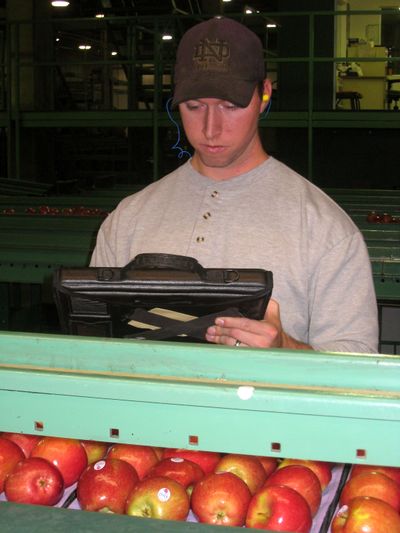inspecting goes Digital
processing by PC saves time, money

YAKIMA – Mark Jolley used to carry armloads of reference manuals and handbooks to the central Washington warehouses where he inspects apples and pears to ensure their quality for the export market.
Now, he’s armed with just a tablet computer.
Portable computers deployed by the Washington state Department of Agriculture at warehouses and packing sheds are speeding the inspection process, while making it easier for industry officials to gather information necessary to market the crop and monitor shipments.
“We’re the only state I’m aware of to put these kinds of tools in the hands of our inspectors,” said Jim Quigley, the Agriculture Department’s fruit and vegetable program manager. “It’s really added another dimension to our inspection programs.”
The fruit and vegetable program inspects several commodities – apples, pears, cherries, asparagus, potatoes, onions, prunes, peaches and apricots – for grade, size and quality to ensure they meet requirements of export countries. The program is crucial, in particular, for the fruit industry, where some $783 million in apples, cherries and other fruit were exported in 2007.
Washington is the nation’s leading producer of apples, growing about half the U.S. crop. The state also is the third-largest exporter of U.S. food and agriculture products, and about one-third of Washington-grown products are shipped overseas.
The Agriculture Department first introduced the computers to inspectors two years ago, but they’re only now being widely used. Inspectors use a stylus to write on the tablet’s screen, selecting criteria from drop-down fields and checking boxes about the quality of the produce.
In one section, inspectors can select a type of fruit from a menu – say, a red delicious apple – and an image of a good-grade red delicious apple appears on the screen. They can then use the stylus to spin the apple on the screen for different views.
Information recorded on the computers is sent to the department’s Web site in short order, making it available in real-time to shippers and trade associations responsible for marketing their crops and monitoring crop movement.
“When we get into November, we’ll have a really good idea of what the crop is,” said Charlie Pomianek, manager of the Wenatchee Valley Traffic Association, which monitors crop shipments. “… Now we can accurately show how we’re doing that throughout the season.”